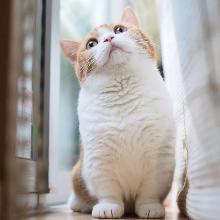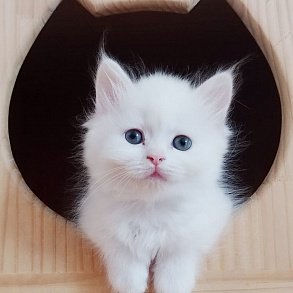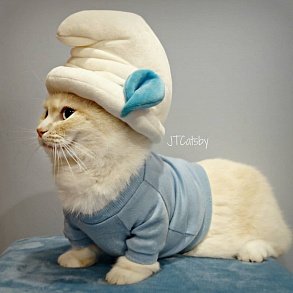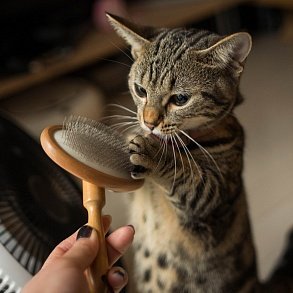Munchkin

Munchkin refers to young breeds of short-legged cats. They are playful, affectionate and friendly creatures.
Brief information
- Breed Name: Munchkin
- Country of Origin: USA
- Time of origin of the breed: XX century
- Weight: from 2.2 to 4 kg
- Life expectancy: 13-16 years old
Highlights
- Munchkins are mobile and inquisitive, often stand on their hind legs.
- Easily get along in a large family, get along with other pets and children.
- Undemanding in care.
- Are prone to lordosis and obesity, so munchkins should be carefully selected, observe the feeding regime.
Munchkin is a breed of cats that is distinguished by shortened paws while maintaining the proportions of the body and appearance of ordinary members of the family. The peculiarity developed as a result of a natural mutation, so the absolute majority of animals have good health. Munchkins are mobile, get along well with other pets, are kind to children. Conventionally, the breed is divided into a semi-long-haired and short-haired line.
Breed characteristics
History of the appearance of Munchkins
In the 30s of the twentieth century in Europe, there were periodic mentions of unusual short-legged cats. The outbreak of the Second World War soon almost completely erased this genetic line. In 1944, one of the British veterinarians reported observations of several generations of cats that were similar to ordinary domestic except for the parameters of the limbs. After the war, such animals were seen in the USA and the USSR. In 1953, Soviet sources dubbed them "Stalingrad Kangaroos", suggesting that the mutation occurred due to their existence in difficult conditions.
The modern development of the Munchkin breed occurred in 1983, when teacher Sandra Hochenedel from Louisiana, returning home, noticed an unusual pregnant cat. The woman took pity and sheltered her, giving her the nickname Blackberry (Blackberry). Half of the kittens that were born also had short legs, which surprised Sandra a lot. She decided to give an unusual pet to her friend Kay LaFrance. So the Blackbury and Toulouse cats became the ancestors of the modern breed.
Sandra and Kay managed to interest Dr. Solveig Pfluger, who served as a judge of the TICA Association, in munchkins. He examined unusual cats and gave an unambiguous verdict – the breed appeared naturally, thanks to changes in the recessive gene that regulates the length of the paws. As opposed to tax and other short-legged animals, short-legged munchkins usually do not lead to back problems.
For the first time the general public learned about the breed at the national exhibition TICA, held at Madison Square Garden in 1991. Most of the viewers and experts were critical of the viability of the Munchkins, branding them as living evidence of breeders' ethics violations. Despite long-term disputes, by 1994 TICA still managed to add the breed to the list of developing ones. In the early 2000s, the Munchkins won the championship title and gained real popularity.
The breed is recognized by the associations TICA, AACE, UFO, SACC and WNCA. The FIF, CFA and Governing Council of the Cat Fancy societies refused to register Munchkins, considering these cats to be genetically defective. TICA solved the issue democratically – only cats whose owners are able to confirm a monopred pedigree in three or more generations are allowed to participate in the show. The Munchkins got their unusual name in honor of the cheerful friendly people from the book "The Amazing Wizard of Oz".
Video: Munchkin
Munchkin's appearance
Munchkins are unique, they cannot be confused with other cats because of their greatly shortened paws. With an average body size, the legs of these cats are 2-3 times smaller than those of other breeds. Despite this mutation, Munchkins have preserved a healthy spine, so they have a mobile, flexible, strong body. The average weight of cats ranges from 2.2 to 4 kilograms.
Munchkins are often crossed with other breeds, so they may differ in appearance and character. Offspring are often long-legged. Such cats do not participate in the show, but can be used for the development of the breed, since the presence of two short-legged parents increases the mortality of kittens in the litter. Breeders are actively developing Munchkins, so the associations have not yet presented strict standards.
Head
Is proportional to the size of the trunk, has rounded contours, the shape of a modified wedge. Cheekbones are high, cats are usually more pronounced than cats. The muzzle is of medium length, the transition of the nose to the forehead is smooth. Some deflection of the bridge of the nose is allowed. The chin is not large, firm.
Eyes
Almond-shaped, medium or large size. A fairly wide fit at a slight angle provides an open expression to the muzzle. Munchkins have no strict connection between eye color and coat color.
Ears
The ears are wide at the base and rounded to the tips. Shells can be medium or large in size, located wide and high. The presence of tassels is allowed only for representatives of the breed with long hair.
Neck
Cats have a larger, muscular, dense neck than cats.
Body
Munchkin's body is elongated, it cannot be called compact. The back has a slight downward slope from the tail to the shoulders. The hips are firm, the chest is rounded. The backbone is medium-sized, the musculature is well developed. Cats are usually larger than cats. Angular shoulder blades are allowed.
Legs
The limbs are short, located at the same distance in the direction of view from the head to the tail. The upper and lower part of the front legs, as well as the hips and the lower part of the hind legs are equal in length. The hind limbs are often slightly longer than the forelimbs. Munchkins have legs of three variants: ordinary, short, very short (Rug hugger).
Paws
Munchkin paws are proportional to the body, have a rounded shape. No outward or inward curvature is allowed.
Tail
Tail and body length are usually the same. The thickness is average, there is a rounded, somewhat narrowed tip. During the movement, the tail comes to an upright position. In the presence of a long coat, this part of the body receives an abundant plume.
Wool
The coat is silky semi-long or velvety short, with an average undercoat.
Colors
The coat color of munchkins can be any, bicolor individuals are often found.
Life expectancy
Munchkins live 12-13 years, but with professional care they are able to live up to 16-20 years.
Possible disadvantages
Too short or long nose, protruding chest bone, round head and eyes, cow-like paws, stocky short body, curly hair.
Disqualifying signs
Deafness, amputated claws, cryptorchidism.
Vices disqualifying for the exhibition
The presence of characteristic features of other breeds, saggy croup, excessively concave back.
Photos of munchkins
Munchkin's character
Munchkin really looks at life and does not complain about its trials, is confident in himself and his abilities, good-natured, curious. To people, these cats seem slightly out of this world. It cannot be said that the character of Munchkins is about the same, it depends on genes, so they have different types of behavior. But in general, these are clockwork animals that relate to people with great sympathy.
Representatives of the breed love outdoor games, the short paws of munchkins do not prevent them from being quite nimble: they jump very smartly on low tables, chairs, and other furniture. And the owners' favorite curtains are also easily stormed by them. Of course, they will not be able to jump too high, but to steal something delicious from the kitchen table, after jumping, for example, on a stool, is a couple of trifles for them.
Munchkins are smart, very friendly, clean animals that quickly get used to new surroundings, people. They retain playfulness throughout life, especially love children. Munchkins are extremely inquisitive, often "borrow" and hide small things to play with them in moments of loneliness, so it's better to hide all valuable, fragile trinkets away. It is advisable to periodically look for such "treasures", since the missing keys, socks, pencils are usually located there.
Munchkins are distinguished by a truly dog-like devotion to the owner, but they have their own character, are able to stand up for themselves. These cats easily tolerate trips, do not resist walking on a harness. An interesting feature of the breed is the ability to sit on its hind legs for a long time, surveying the surroundings. At the same time, the front paws hang funny along the body, so Munchkins are often called "kangaroo cat".
Care and maintenance
This breed is easy to maintain, does not require special care. Experts recommend following a few simple rules.
- Despite the companionable nature of cats, they really like to "build nests" in order to feel protected during rest. Put a basket, a small sturdy box or another house with a soft litter for the munchkin.
- Get a deep tray, because clean pets actively bury waste and are able to litter around.
- Combing short–haired munchkins is enough 1 time a week, long-haired ones - 2 times. The main thing is to prevent the occurrence of tangles.
- Bathing these cats is enough 1 time in 3-4 months with special shampoos.
- Changing claws is usually easy for Munchkins, especially if there is a scratching post in the house. 1 time in 2-3 weeks it is worth checking the condition of the paws to help the pet if necessary.
- Clean the ears should not be deep and very carefully, about 1 time a month.
- It is undesirable to let cats go for an independent walk, because a squat animal often looks like it is preparing for an attack, which may be incorrectly perceived by other pets or people. Because of the short paws, the munchkin can be injured.
- Munchkins should be fed moderately, because, despite their high mobility, they are prone to obesity. Provide frequent replacement of drinking water, proper nutrition.
- Using special toothpastes once a month, you can successfully prevent the development of oral diseases in Munchkins.
As for nutrition, it is not recommended to feed the cat from the common table. Use specialized or separately prepared natural food. These types of food should be alternated, but not mixed in one plate. Do not buy cheap food, because they are similar to fast food for people. Are you going to cook food for Munchkin at home? Experts advise to make a diet in this way:
- 60% – raw or boiled meat (rabbit, beef, offal);
- 30% – boiled or raw vegetables;
- 10% – porridge.
Munchkins should not be treated to salty, sweet, fried, smoked, bean dishes, fish, fatty meats (lamb, pork). An adult cat can be fed a couple of times a day, kittens – up to 6 times a day.
Munchkin's Health
Munchkin is a young breed with an actively expanding gene pool, so its representatives rarely suffer from congenital diseases, have good immunity. Owners should know that such cats are characterized by some intolerance to plant foods, so its share in the diet should be small. Sometimes there are cases of congenital lordosis – excessive deflection of the spine in the area of the shoulder blades.
Munchkins can suffer from lordosis. This is a disease in which the muscles supporting the spinal column are weakened, and it moves into the chest cavity, while pressing on the heart and lungs. A slight curvature will not cause problems, but it can be aggravated by injuries, obesity. Serious lordosis causes breathing difficulties, increases the load on the heart muscle, which can lead to diseases. However, lordosis is a rare enough ailment. By the way, other cat breeds can also suffer from it.
Since the munchkin's short paws are a consequence of a natural genetic mutation, the paws of some kittens can be short, others — ordinary or long. If the gene responsible for short limbs gets to the embryo from both parents, it can be fatal.
How to choose a kitten
The rules for the selection of Munchkin kittens are standard: take mobile, clean babies at the age of 12 weeks with the necessary vaccinations. Contact only reliable kennels offering registered animals. This will allow you to get a really healthy kitten, without serious birth defects. Munchkins have won the love of a wide audience, so real queues often line up behind them. If you do not care about a certain gender, type of color, length of coat, you can get a kitten quickly enough. You should not buy munchkins at bird markets or by private ads, tempted by the low price. This can result in prolonged treatment of the animal or the acquisition of a non-viable individual.
Photos of Munchkin kittens
How much does a munchkin cost
The price of a Munchkin kitten in Russia ranges from $30 to $400, depending on gender, color, length of coat, specific breeder. It is customary to cross Munchkins only with healthy domestic cats of similar appearance or with each other. Hybrid kittens that have inherited the characteristics of other breeds are not allowed to show, so they are sold at a reduced price. They do not differ in character from their counterparts and sometimes look nicer than the exhibition ones. Healthy pets with other appearance features that cause disqualification at competitions will also be cheaper. This is a great opportunity to get a devoted four-legged friend inexpensively.


